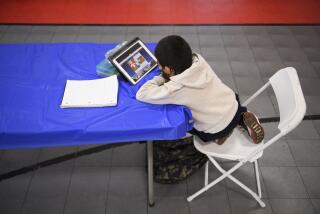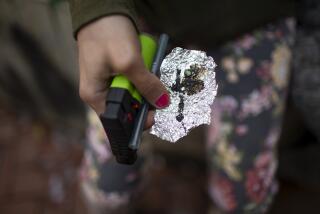A High-Tech Hot Spot in Oregonâs High Desert
HERMISTON, Ore. â Barreling down U.S. Highway 395, through remote farmland not far from a massive storage facility for old chemical weapons, Fred Ziari beckoned his passenger to jump on the Internet.
âOK, go ahead,â Ziari, an Iranian-born wireless communications entrepreneur, said with a touch of glee. âLaunch your browser. Itâs free!â
Fast, free broadband wireless access to the Internet might seem an unlikely amenity for this part of the country. But in a roughly 700-square-mile area stretching across five counties in eastern Oregon and Washington state, unimpeded wireless fidelity, or Wi-Fi, access is being given a unique trial run by individuals, police departments, shippers and even onion brokers.
The reason this wireless hot spot -- believed to the largest in the nation -- was set up in the first place was not for those potential users, however. It was built as an emergency communications system in the event of a leak at the Umatilla Chemical Depot, where nearly 4,000 tons of sarin, mustard and other Cold War-era nerve gases are stored in concrete igloos.
The wireless network, which cost about $5 million to set up, is almost entirely paid for from federal, state and local emergency-preparedness funds. Ziari runs the private company that built and maintains the system, EZ Wireless.
In a disaster, officials here say, the wireless network will provide vital communications across the area about evacuation plans and the wind direction.
Despite that sobering reality, residents seem to be looking at the brighter side of the networkâs usefulness, including its potential to attract business to the area.
In cities and suburbs across the nation, proposals for free or reduced-cost Wi-Fi access to the Internet pit a self-styled populist movement against cable and telephone industries that have spent billions laying connections to homes and businesses.
While âWi-Fi for allâ proponents liken the amenity to municipal water or interstate highways, critics say itâs an unfair public subsidy in what should be a private marketplace.
All those arguments seem beside the point in the Hermiston area, where many houses and farms are so far out in the country that they have neither cable nor high-speed DSL lines. Thus, the wireless network faced little protest when it was started up two years ago.
Ziariâs system uses dozens of antennas to pick up and broadcast a signal. Technically a combination of short-range signals known as Wi-Fi and longer-range ones known as WiMax, the combined effect creates a wireless âcloudâ allowing access from almost anywhere in the Hermiston area.
âIt has opened our eyes to all kinds of possibilities,â said Kim Puzey, general manager of the Port of Umatilla, which is near the convergence of the Columbia and Snake rivers and is one of the largest grain ports in the country. âWeâre no longer confined by wires.â
Port workers, farmers and shippers, who are spread across a vast area, already communicate about shipments via the network.
The port also plans to set up a network of cameras at key shipping and storage points that will be accessed via the Internet and, officials say, will provide a vastly improved security system.
Longer range, Puzey said, the port envisions an electronic tag system that will not only verify for shippers where their goods are, but also let them see the goods.
âItâs sort of a step beyond even where FedEx and UPS are now with their tracking systems,â Puzey said.
Itâs a potential competitive advantage -- Oregonâs wheat farmers, for instance, sell their grain around the world, so an Internet tracking system could allow them to show the product directly to a potential buyer in Pakistan or Thailand.
Bob Hale, one of the Subway sandwich chainâs biggest suppliers of red onions, already can do that with a digital camera. He often takes photographs when heâs out in the fields and sends them via his laptop to potential buyers. Then he calls them on his cellphone.
âIâll say, âYou see that onion Iâm showing you? Iâm going to harvest it tomorrow and send it to you,â â Hale said. âCustomers love that.â
Hale, the president of Hermiston-based American Onion, uses the wireless network for everything from checking sports scores to monitoring aerial photos of his 40,000-acre farm. That allows him to see potential trouble spots right away -- for instance, an area where a sprinkler is plugged with dirt and not properly irrigating his plants.
âVegetables are very temperamental,â Hale said. âTiming is everything in the vegetable business. Theyâre like kids, actually. When they need something, especially water, they need it right now.â
Another enthusiastic user of the network is Dan Coulombe, the chief of Hermistonâs 23-officer Police Department.
âOur officers now can get and send information directly over the Internet,â said Coulombe.
âThey donât have to come in to write up every single report,â including traffic infractions in which a suspect is not brought in for booking. âThey file their reports directly off a laptop in the squad car. Thatâs saving us 2,000 hours of time annually right there.â
Coulombe also said he envisioned a time when officers everywhere could tap into Internet-based criminal records rather than calling in for information from a harried dispatcher.
People here readily acknowledge that the wireless system would probably not have been affordable were it not for the Armyâs chemical depot, a giant fenced-off complex several miles outside Hermiston.
Local schools conduct regular lockdown drills in preparation for a deadly leak -- all windows and doors are sealed shut and the air is filtered.
On Hermistonâs main street, a rather jarring exhibit of chemical-weapons history and safety suits is on display at the federally funded Umatilla Chemical Agent Disposal Facility outreach office.
There has never been a severe spill or leak of the nerve gas, much of which is being destroyed under provisions of international treaties that ban their use. And so residents tend to look at the upside of their free wireless network, which in some respects puts the area further into the techno-future than many urban areas.
Ziari, 52, whose pockets are bulging with gadgets -- cellphones, hand-held organizers, a global positioning device and several credit card-sized wireless modems -- trained as an agricultural engineer at Texas A&M.; He is energized by the potential of wireless technology.
âWe are bridging the digital divide here,â he said as he zoomed around the back roads of eastern Oregon, his passenger sending e-mail from a laptop. âI really believe this technology is going to revolutionize the world.â
Ziari sees a time when the cost of wireless technology falls so low that it can be used across the Third World, leapfrogging over the conventional need for telephone or cable lines.
One often hears how hard and expensive it is to âgo the last mile,â a phrase used by cable and telephone companies for stretching their lines to users in homes and offices.
âWell, weâre going the last mile,â said Ziari, speeding away from downtown Hermiston and into the lonesome high desert, âand then weâre going several miles after that.â
More to Read
Sign up for Essential California
The most important California stories and recommendations in your inbox every morning.
You may occasionally receive promotional content from the Los Angeles Times.









